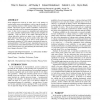Free Online Productivity Tools
i2Speak
i2Symbol
i2OCR
iTex2Img
iWeb2Print
iWeb2Shot
i2Type
iPdf2Split
iPdf2Merge
i2Bopomofo
i2Arabic
i2Style
i2Image
i2PDF
iLatex2Rtf
Sci2ools
ISCA
2007
IEEE
2007
IEEE
Matrix scheduler reloaded
From multiprocessor scale-up to cache sizes to the number of reorder-buffer entries, microarchitects wish to reap the benefits of more computing resources while staying within power and latency bounds. This tension is quite evident in schedulers, which need to be large and single-cycle for maximum performance on out-of-order cores. In this work we present two straightforward modifications to a matrix scheduler implementation which greatly strengthen its scalability. Both are based on the simple observation that the wakeup and picker matrices are sparse, even at small sizes; thus small indirection tables can be used to greatly reduce their width and latency. This technique can be used to create quicker isoperformance schedulers (17-58% reduced critical path) or larger isotiming schedulers (7-26% IPC increase). Importantly, the power and area requirements of the additional hardware are likely offset by the greatly reduced matrix sizes and subsuming the functionality of the power-hungr...
Hardware | ISCA 2007 | Larger Isotiming Schedulers | Matrix Scheduler Implementation | Quicker Isoperformance Schedulers |
| Added | 03 Jun 2010 |
| Updated | 03 Jun 2010 |
| Type | Conference |
| Year | 2007 |
| Where | ISCA |
| Authors | Peter G. Sassone, Jeff Rupley, Edward Brekelbaum, Gabriel H. Loh, Bryan Black |
Comments (0)

